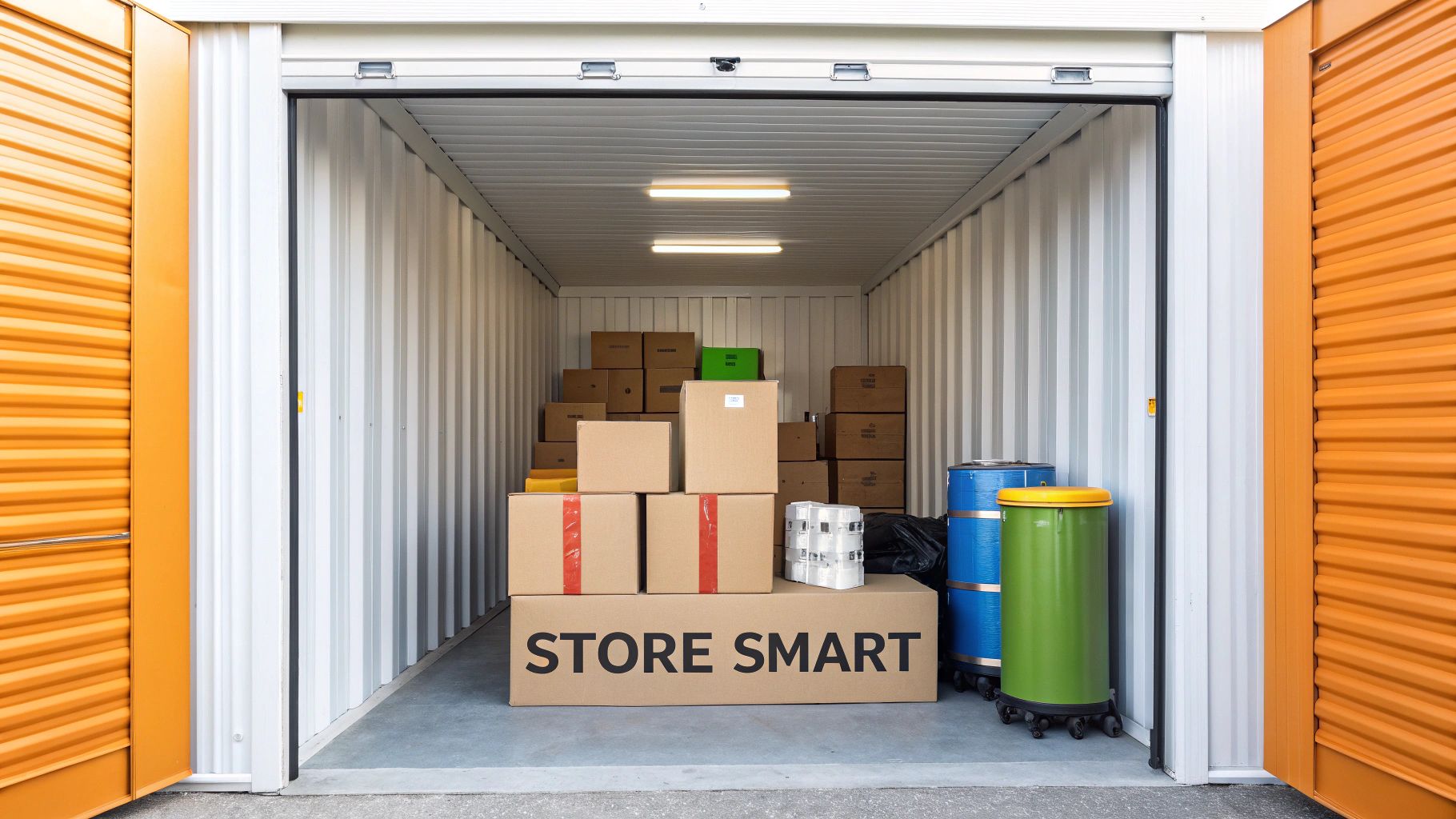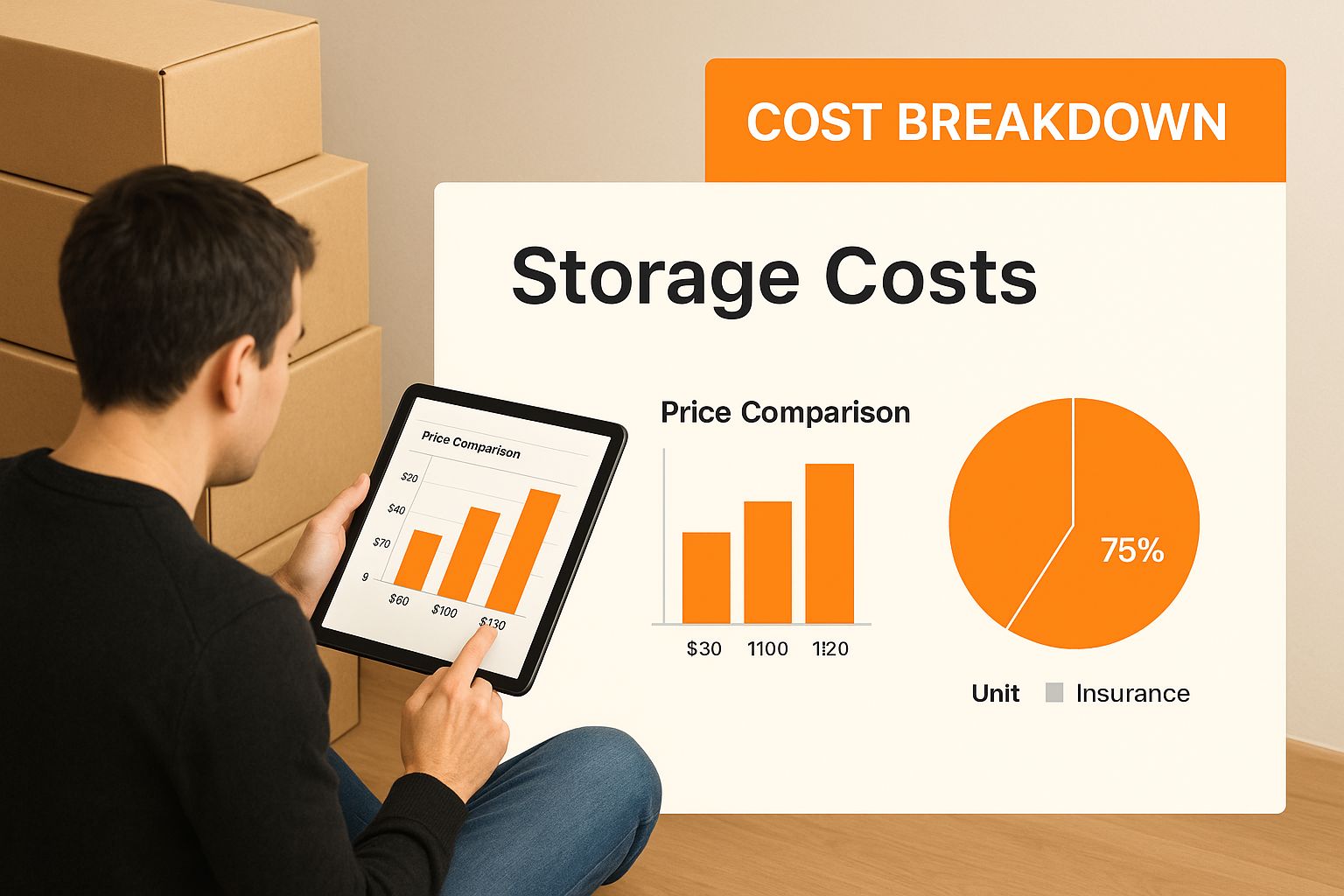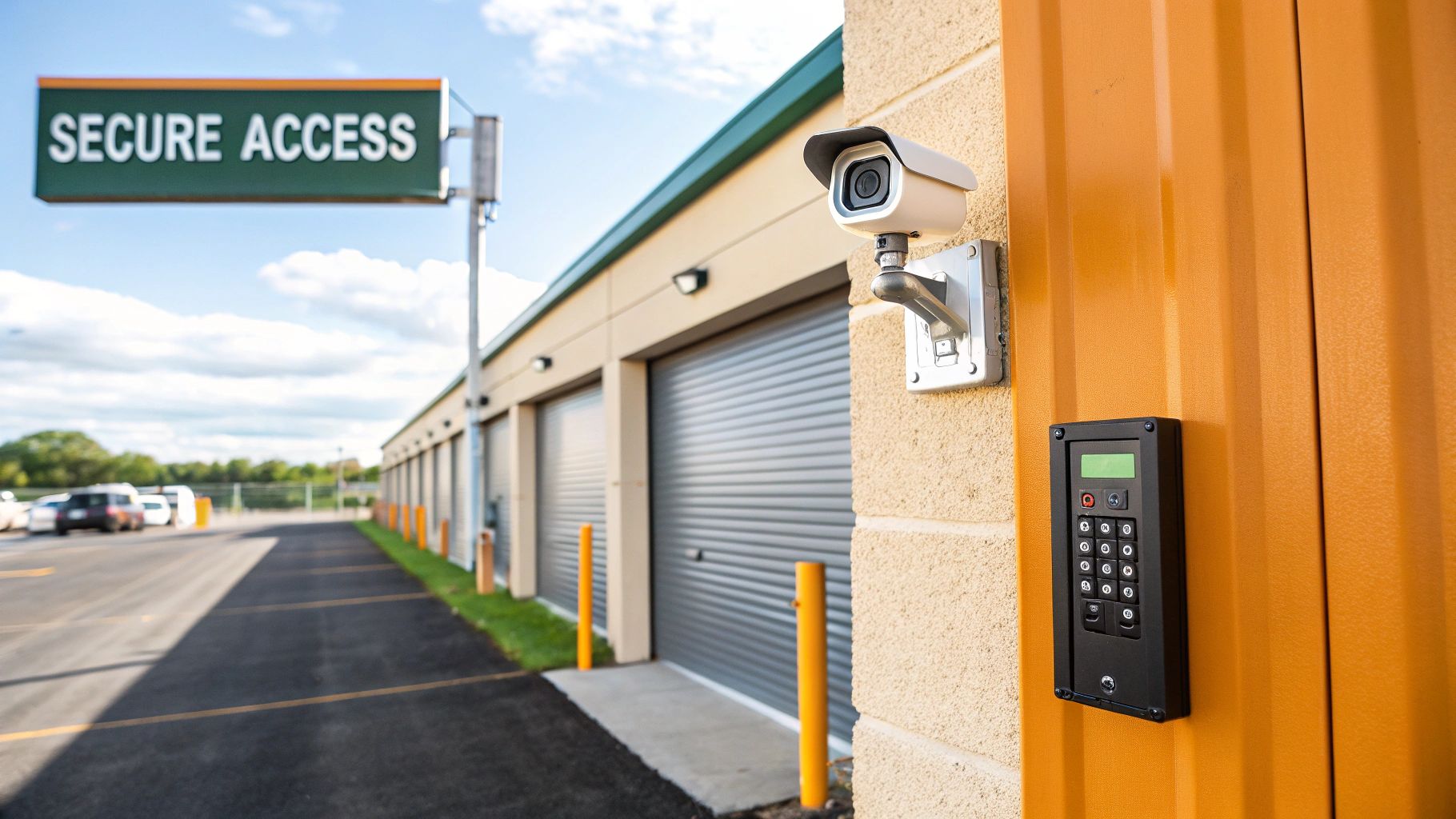Sometimes, a few extra square metres can be all it takes to ease the pressure. You might find yourself Googling “temporary storage near me” when your home or workspace starts to overflow. Whether you’re between leases, tackling a major clear-out or making room for business stock, a short-term unit can be the perfect pit stop.
Why You Might Need Temporary Storage
Life throws curveballs, and sometimes your belongings need a pit stop. A big move abroad—relocating to a new country like the Netherlands—is the obvious case. Yet you don’t have to be moving continents to realise you need a short-term solution.
Even smaller shifts can create a space crunch. Clearing out your loft for guests, repurposing a garage into a home studio or taking a sabbatical can leave you juggling boxes at home.
The UK self storage sector has been on a sharp upward trajectory. Turnover recently tipped £1.2 billion, while total floorspace expanded by 7.2% to reach 64.3 million square feet. As providers race to stand out, expect to find climate-controlled options, app-based access and 24/7 CCTV across most modern sites. You can understand more about the future of UK self storage.
Booking a unit today often takes less than five minutes online. You can compare prices, check availability in real time and secure access codes before you even load the van.
Common Reasons For Renting A Unit
When I speak to customers, their needs tend to fall into a few familiar categories. See if any of these ring true for you:
- Moving House: Bridge the gap between selling one property and settling into another without squeezing everything into a single day.
- Decluttering and Renovating: Free up floor space to paint, replace flooring or fit new cabinets without risking damage to furniture.
- Business and Commercial Use: Archive documents, store excess stock or stow tools securely without the commitment of a larger lease.
- Seasonal Storage: Stow garden furniture over winter, pack away festive decorations or keep sports gear safe when it’s not in use.
Key Takeaway: Temporary storage adapts to almost any challenge. Pinpointing your reason—be it a house move or commercial overflow—helps you select the right unit size, access hours and security features.
Of course, everyone’s situation is unique. Some people use a unit just to clear a spare room before a family visit, while others keep heirlooms safe during extended travel. Whatever your scenario, planning ahead ensures you pick a solution that works.
If you’d like to discover even more ways self storage can simplify your life, check out the 7 benefits of self storage in our detailed guide.
How to Find the Best Local Storage Options
So, you’ve typed “temporary storage near me” into your search bar. That’s a great start, but finding the right unit takes a little more digging than just a quick Google search. The first thing most of us do is explore reliable storage solutions online to see what’s out there, and digital tools are definitely your best friend here.
I always recommend starting with a map-based search. Tools like Google Maps are perfect for this because they give you an instant visual of every facility in your area. This is a bigger deal than you might think—after all, a staggering 46% of all Google searches are for local information.
Seeing everything laid out on a map cuts through the noise.
This simple visual helps you immediately spot which facilities are actually convenient. Is it on your way to work? Close to your new flat? Or tucked away on the other side of town? You can rule out the inconvenient options in seconds.
Refining Your Search Terms
Now it's time to get specific. A vague search will flood you with generic results, but adding key features to your query will pull up the facilities that genuinely meet your needs.
Instead of just searching for "storage," try something more targeted:
- "24-hour access storage units in [your town]"
- "Climate-controlled temporary storage near me"
- "Drive-up container storage in [your postcode area]"
This small tweak makes a huge difference. You're telling the search engine exactly what you’re looking for, which filters out all the places that don’t offer what you need. It’s a massive time-saver. If you need more pointers, our guide on 10 tips for choosing a self-storage facility is packed with helpful advice.
Expert Insight: Don't get completely hung up on the price. A unit that costs a little more but offers better security or 24/7 access often delivers far more value and peace of mind in the long run.
Once you have a shortlist, the real work begins: digging into online reviews. Look for recent, detailed feedback that talks about cleanliness, security, and especially customer service. How management responds to negative comments is very telling—it shows you how much they care about their customers. A string of unresolved complaints is a major red flag you shouldn’t ignore.
Choosing The Right Storage Unit Size and Type
Getting the unit size right is probably one of the most critical decisions you'll make when you start looking for temporary storage. I’ve seen it happen time and again: people either end up paying for space they don't need or face the nightmare of a packed-out unit with a pile of boxes still on the pavement. It’s a common, frustrating, and often costly mistake.
Your first big decision is whether to go for an indoor unit or an outdoor container. They might seem similar, but they serve very different purposes.
Indoor Units vs Outdoor Containers
If you’re storing anything remotely sensitive, an indoor unit is your best bet. Think about wooden furniture that could warp, electronics that hate dust, or important documents that need stable conditions. These units are tucked away inside a larger building, offering much better protection from the UK’s notoriously unpredictable temperature swings and humidity.
Outdoor containers, on the other hand, are all about durability and easy access. They are almost always drive-up, which is a massive plus when you’re trying to load or unload bulky items like garden machinery, business stock, or just heavy furniture. That convenience is a huge reason they’ve become so popular across the country.
In fact, out of 2,915 self-storage sites nationwide, a remarkable 1,135 are now container storage facilities. Their rapid growth is especially noticeable in rural and semi-rural areas where there’s more land available, making them a really accessible choice for lots of people. You can discover more insights about the UK's storage landscape.
A solid grasp of the costs is essential before you commit. This image gives you a good idea of the typical factors that influence the price.
As you can see, the main things driving the cost are the unit's size, its location, and any extra features like climate control.
Estimating Your Required Space
Trying to visualise how all your belongings will fit into an empty space is easily the trickiest part. Guesswork can be expensive, so it's much better to compare unit sizes to spaces you're already familiar with.
To help you out, here’s a quick guide to common self-storage unit sizes.
Quick Guide to Self-Storage Unit Sizes
This table should help you picture what fits into the most common unit sizes, taking some of the guesswork out of choosing the right option for your stuff.
| Unit Size (sq ft) | Equivalent To | What It Typically Holds |
|---|---|---|
| 25 sq ft | Large walk-in wardrobe | Contents of a small room or garden shed. Perfect for boxes, a small mattress, or seasonal items. |
| 50 sq ft | Large garden shed | Furnishings from a one-bedroom flat, excluding large appliances. Ideal for sofas and chests of drawers. |
| 75 sq ft | Small single garage | Contents of a two-bedroom flat. Suitable for most household furniture and some appliances. |
| 100 sq ft | Large single garage | Furnishings from a three-bedroom house, including major appliances like washing machines and fridges. |
Hopefully, this gives you a much clearer starting point. Remember, it’s often wise to go slightly bigger if you’re unsure—it’s far less stressful than running out of room on moving day.
Right, you've done the online legwork and have a few potential storage facilities on your shortlist. Now it’s time to dig a bit deeper than the online reviews. This is where you confirm that the "temporary storage near me" you found online actually lives up to its promises.
First things first, let's talk security. Don't just accept what their website says; ask for a proper look around. You're looking for comprehensive CCTV that covers more than just the front gate. Are the driveways, corridors, and loading bays all under surveillance? A secure electronic gate is a given, but a crucial follow-up question is whether the individual units are alarmed. That extra layer of security can make all the difference.
Getting the Full Picture on Access and Insurance
Next up, get crystal clear on their access hours. If you’re a tradesperson needing to grab tools for a 6 AM start, or you're moving house and might need to drop things off late, a facility that only operates standard 9-to-5 hours just won't cut it. Pin them down on what "24/7 access" really means – is it genuine, anytime access, or are there restrictions?
Crucial Question: "What is your notice period, and are there any hidden fees for moving out early?" Some agreements have sneaky clauses that can trip you up, so it's vital to get this ironed out before you commit to anything.
Insurance is another detail you can't afford to skim over. Most facilities will insist you have it, but their in-house policy might not cover the full value of your belongings. Ask for the specifics of their coverage and then compare it to the cost of extending your own home contents insurance. Sometimes, your existing policy offers better value.
Making a Confident Decision
Before you even think about signing on the dotted line, have a final list of questions ready for the manager. Getting clarity on the small print now will save you a world of headaches down the road.
- Payment and Fees: Are there any one-off administration fees, charges for a new lock, or penalties for late payments?
- Access Protocols: How does out-of-hours access actually work? Is there a specific procedure you need to follow?
- Prohibited Items: Get a clear, written list of what you're not allowed to store. You don't want to accidentally breach your contract.
It's also worth knowing that storage availability isn't uniform across the country. For example, the South East is seeing a 6.3% growth in storage inventory, whereas the North West is at 4.9%. These figures, highlighted in a market analysis on Storeganise.com, show how regional demand can impact what's available.
Once you have all this information, you’re in a much stronger position to choose the right facility with confidence. For a detailed guide on the final steps, check out our post on how to rent a storage unit.
Booking and Preparing Your Items for Storage
You’ve found the perfect unit—now you’re on the home stretch. The last bit of admin is sorting out the booking and getting your items ready for their temporary home. A little prep work now goes a long way in keeping everything safe, sound, and organised.
Finalising the rental agreement is usually quite simple, but it’s worth paying attention to the details. Before you sign anything, make sure you’re clear on the notice period for ending the rental and scan the list of prohibited items. For safety reasons, most facilities won’t allow you to store things like hazardous materials, perishable food, or anything flammable.
You’ll also need to have your documents handy. This typically means a valid form of photo ID, like a driving licence or passport, along with a recent proof of address (a utility bill or bank statement usually does the trick).
Smart Packing Strategies
How you pack your belongings is just as crucial as where you decide to store them. Getting it right from the start prevents damage down the line and makes it much easier to find things later. Trust me, a bit of organisation now saves a mountain of hassle.
- Label Everything: Grab a thick marker and label every single box on at least two sides. Note down the contents and which room it came from.
- Create an Inventory: Keep a running list on your phone or in a notebook of what’s inside each box. This is an absolute lifesaver if you need to pop back and grab one specific item.
- Protect Fragile Items: Don't be shy with the bubble wrap or packing paper for anything breakable. You want to make sure there’s no empty space left in the box, as shifting items are a recipe for disaster.
Pro Tip: Always stack the heaviest boxes at the bottom and work your way up with the lighter ones. This creates a stable base and stops things from getting crushed. I also recommend leaving a small aisle down the middle of your unit so you can actually get to the items at the back without unpacking the whole lot first.
If you’ve decided to get some professional packing help, they’ll handle the heavy lifting. But for those doing it yourself, taking a moment to plan your layout is key.
For more practical advice on making the whole process as smooth as possible, check out our super easy packing tips. They’re packed with extra guidance to get you sorted.
Got Questions About Temporary Storage?
Even with all the planning in the world, it's natural to have a few last-minute questions pop up when you're looking for temporary storage. To clear up any lingering doubts, here are the answers to some of the most common queries we get from customers.
What’s the Going Rate for Temporary Storage in the UK?
Honestly, it varies quite a bit. The final price tag depends on the unit's size, where it's located, and whether you need special features like climate control.
For instance, a small 25 sq ft unit in a big city like London might set you back £25-£30 per week. If you need something larger, say a 100 sq ft unit in the same area, you could be looking at over £60. Prices tend to be friendlier in less populated areas, and container storage is often a more budget-friendly route.
Always ask about introductory offers, but don't forget to confirm the standard rate you'll be paying once the deal ends.
A Pro Tip From Experience: While most facilities offer their own insurance for convenience, it’s always worth checking if your existing home contents insurance can be extended to cover your stored items. It can sometimes be a more cost-effective option, but double-check that the coverage is enough to replace everything if the worst were to happen.
Do I Really Need Insurance for a Storage Unit?
Yes, it's pretty much a non-negotiable. Almost every storage facility in the UK will require your goods to be insured before you can move them in. Think of it as a safety net that protects both you and the storage provider.
You'll generally have two paths to take:
- Go with the insurance policy offered directly by the facility.
- Sort out your own cover, which often means extending your current home contents policy.
What Am I Banned From Storing in My Unit?
For everyone's safety and hygiene, every facility has a strict list of prohibited items. Bending these rules isn't worth it, as it can lead to your rental agreement being terminated.
Here's a quick rundown of the usual suspects on the banned list:
- Flammable or hazardous materials: This means no petrol, paint, gas canisters, or corrosive chemicals. It's a major safety hazard.
- Perishable foods: Anything that can spoil, rot, or attract pests is a definite no-go.
- Illegal goods or weapons: This is a zero-tolerance policy across all reputable facilities, for obvious reasons.
- Living things: You can't store plants or animals in a storage unit.
Before you start packing your boxes, take a moment to review your chosen provider’s specific list of restrictions. It’s a small step that ensures a smooth, hassle-free storage experience from day one.
Ready to find a secure, flexible, and convenient storage solution? At Standby Self Storage, you can check prices, book a unit online, and move in today. Visit https://www.standbyselfstorage.co.uk to get started.




